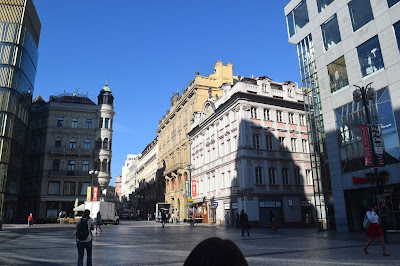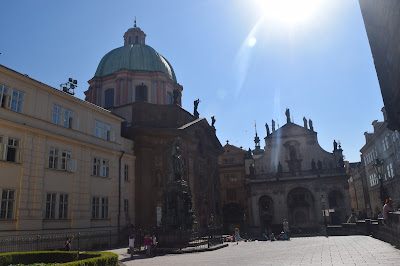Prague, Czechia: The Former Seat of Holy Roman Empire Part 1
Being a born Catholic myself, the Holy Roman Empire has always caught my interest. So, it is natural for me to be fascinated by Rome and perhaps other cities that had been the capital of Roman Catholicism, including Prague. Furthermore, Central and Eastern Europe has become so interesting for me, especially how these countries where shaped by the Cold War and the two World Wars affecting Europe. These two reasons are the primary reason why I opted to visit the Czech Republic.
Czech Republic is composed of the historic territories of Bohemia, Moravia and Czech Silesia. The Bohemian capital is Prague. This has become the capital of the Czech republic after the Great Moravian Empire lost power to the dynasties running Bohemia. Both Bohemia and Moravia have been in one or another subject to influence of the Germans and the Austrians, after the fall of the Holy Roman Empire. As a result, the unique cultural blend has made Prague one of the most popular tourist destination in Europe. And so I was motivated to visit several places in Prague.
This is the Part 1. Click here for Part 2.
1. Kostel sv.
Ludmily
This is a
Catholic church in the Square of Peace. This is a typical neo-Gothic building
in the 19th century. This is dedicated for Saint Ludmila, the first
Czech saint.
2.
Pomník svatého Václava
This is monument
of Saint Wenceslas, the grandson of the Saint Ludmila. The statue is a great
reminder of the Czech statehood and the effort to preserve the cultural and
spiritual tradition of Czech Republic.
3.
Národní muzeum
The
National musuem contains large collection of items from the area of natural
history, history, arts and music. During my visit, the museum has been
renovated, such that the beauty of the museum could not be appreciated.
4.
Čelakovského sady
This is
the street alongside the National Museum. It is a dark ally during the night,
where some people stroll in.
5.
Václavské náměstí
This is recognized as the Horse
Market or Wenceslas Market. This is
the Prague’s cultural and economic center. This square, which connects the National
Museum with the Old Town is a traditional place for demonstrations and mass
gatherings.
6.
Na Přikopě
This is
street where the headquarters of the Czech National Bank, old palaces and luxurious
shops are located. This separates the Old Town’s Republic Square and the
Wenceslas Square.
7.
Svatý Kříž
The Holy
Cross is the universal symbol of Roman Catholic church. This shows the deep
connection between State and Church, as exhibited in this square.
8.
Prašná brána
The
Powder Tower is late Gothic building, next to the Municipal House. This is
considered to be one of the major landmarks in Prague, since the gate provides
access to the street forming the royal route towards the Prague Castle.
9.
Pomník mistra Jana Husa
This
monument is erected in commemoration of Jan Hus, a labeled heretic by the Roman
Catholic Church in his time. This is because Hus has fought for the Church’s
Reformation, which led to the Protestant Reformation, spearheaded by his
successors Luther, Calvin and Zwingli.
10. Chrám
svatého Mikuláše
The
Church of St. Nicholas is a Baroque church in the Old Town Square. It was
originally built using Gothic architecture but was rebuilt in the 17th
century. During the socialist era, the church tower has been used as a watch
tower for American and Yugoslavian embassies.
11. Staroměstská
radnice
The Old
Town hown was established in the 13th century under the economic support
provided by the King of Luxemburg. It consists of complex of several buildings
adjacent to the Old Town Square.
12. Chrám
Matky Boží před Týnem
The
Church of Our Lady before Tyn is the one of the most artistically important
Prague churches. The Church has been controlled by the followers of Jan Hus for
two centuries and thereafter began an era of recatholicisation in the late 16th
century.
13. Kostel sv.
Jiljí
This is a
Gothic Catholic Church at the Dominican Monastery in the Old Town of Prague.
The church was also controlled during the Hussite wars and thereafter donated
to the Dominican order, who built a large monastery.
14. Kostel
Nejsvětějšího Salvátora
The
Church of St. Salvator is the largest temple of the Jesuits in Prague. The church
is a reminder of the Jesuits influence in Bohemian history. The entrance of the
church is facing the Charles Bridge.
15. Karlův
most
The
Charles Bridge is the oldest bridge in Prague across the river Vltava and the
second oldest in the Czech Republic. This has been used as major stop on the
European trade routes and was considered part of the Royal route towards the
Prague Castle. The bridge also played an important role in the history of Roman
Catholic Church, such that many religious figures stand in the bridge.
16. Kostel
svatého Františka z Assisi
Thsi is a
church near the square facing the Charles Bridge. It was built in Baroque style
and was consecrated in the 16th century. A hospital and a convent
used to be operational, next to the church.
17. Česká
filharmonie
The Rudolfinum
is a Neo-classical building on the right bank of the river Vltava. It is the
headquarter of the Czech Philharmonic Orchestra,
18. Josef
Mánes
The
Statue of Josef Manes is situated near the Rudolfinum. Manes is the represantive
of the Czech Romanticism and was considered to be the founder of the
personalities of the Czech visual arts and master of landscaping.
19. Mánesův
most
This is
the tenth bridge over Vlatava Rive. The bridge was formerly the Rudolf Bridge,
next to the Rudolfinum. The bridge was only finally completed during the First
World War.
20. Židovske
muzeum v Praze
This is
one of the most visited musuems in the Prague, housing a large collection of Jewish
artifacts, books and rich archives. During the Nazi establishment of the German
Protectorate of Bohemia and Moravia, the Jewish museum was maintained to created
museum of a dwindling or near-to-extinction race.
21. Červená
This is a
street in between two Jewish synagogues near the Jewish museums. The street is famous
due to the odd shaped of the buildings along the small alley.
22. Kostel sv.
Ducha
The
Church of the Holy Spirit is another Gothic church built in 14th
century. There used to be a Benedictine monastery nearby the church. This
parish is considered instrumental in the conversion of the nearby Jewish
communities to Catholicism.
23. Právnická
fakulta Univerzity Karlovy
The
faculty of Law of Charles University is housed in a Neo-classical building near
the Cech Bridge. The university was founded in the 13th century.
24. Čechův
most
This is
the shortest of all bridges traversing the Vltava River. A tram line passes
through the bridge. The sturdiness of the bridge withstanding increased traffic
is due to its steel arches, considered to be the only bridge with such
construction materials in Prague.
25. Vltava
This is
the considered to the national river of the Czech Republic, being the largest
in country. This river traverses north across Bohemia, before merging with
German river Elbe. There is a total of 18th bridges in Prague
running through the river.
26. Letenský
profil
This is a
natural monument located in the North region of Prague. Its rock formation
provides a very good view of the entire city of Prague.
27. Kramářova
vila
This
villa building is the residence of a well-known Czechoslovakian prime minister.
Since 1998, this has become the official residence of the Prime Minister of
Czech Republic.
Interestingly, Prague has many Catholic church but only about 10% of its population identify themselves as Catholics. This could be a result of a long history of socialist-communist rule in the area. This is quite a big contrast to Prague's rich history in the Holy Roman Empire and counteracting Protestant Reformation. This leaves me asking myself, are the churches in Prague mainly for tourism purposes, instead for religious objectives? Perhaps, you could give me the answer.










































Comments
Post a Comment